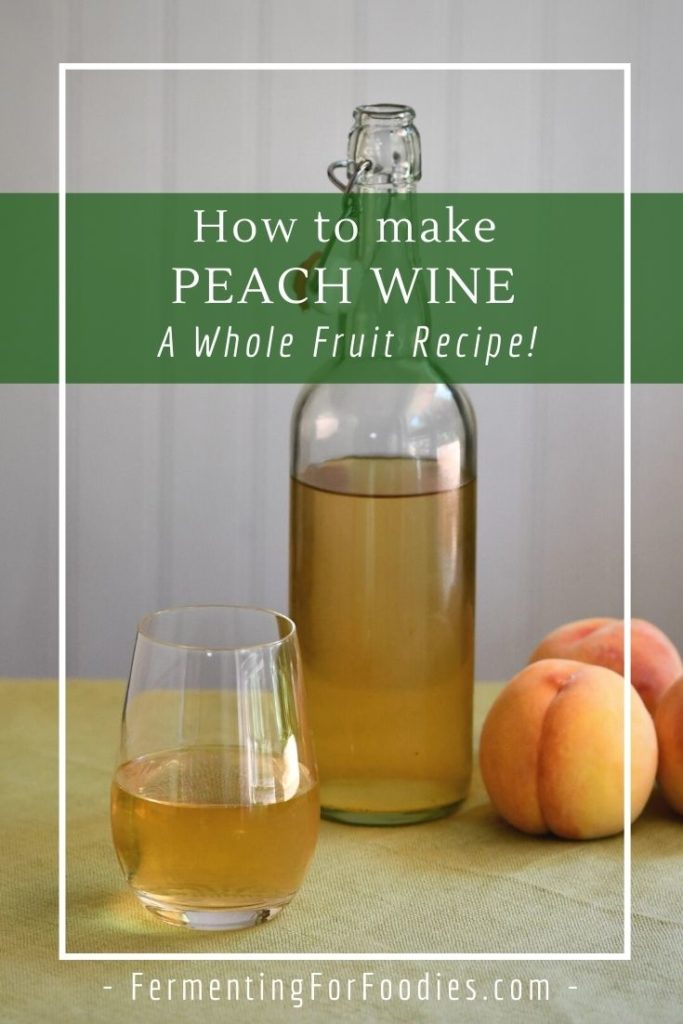
Peach wine is a sweet, golden-colored wine that is full of the ripe flavor of summer. I like to drink it cold, like a glass of sweet white wine, or mixed with a bit of sparkling water for a refreshing afternoon cocktail.
The Perfect Fruit and Peach Wine
The recipe is written for using just peaches, however, I usually make a blended peach wine by using a mix of peaches and other fruit. It just provides a more full and balanced flavor.
Peaches provide both sugar and acidity required to help this wine ferment properly. As such, you don’t want to replace more than 1/4 to 1/2 of the peaches in the recipe below. To replace a portion of the peaches, exchange them by weight and follow the rest of the instructions just as they are written.
Here are a few recommend peach wine fruit mixes with the amount of fruit that should be used in combination with the peaches.
- Rhubarb: I know it’s an unusual mix, but it is my absolute FAVORITE. Something about the tartness of the rhubarb just tastes right when combined with peaches. Replace up to 1/4 of the peaches with finely diced rhubarb stalks.
- Berries: For a cup full of summer, replace up to 1/3 of the peaches with ripe, fresh berries.
- Plum; Plums contain a lot more of the necessary nutrients for winemaking. You can easily replace up to half of the peaches in this recipe with plums.
- Pear: Pear and peach wine is a delicious combination. The pear perfectly complements the flavor of peach without masking it in any way.
Wine-making Tips and Tricks
The recipe is written for someone who already knows a bit about how to make wine. If this is your first time, I recommend reading some of my general winemaking posts.
- To learn about equipment needed, how to rack and bottle wine, and everything else you might need to know check out my general post on How to Make Cider and Wine.
- Here’s a post on How to Use a Hydrometer, to help you determine the alcohol content of your wine.
- The fermentation of alcohol also can involve a small amount of methanol production. However, the amount of methanol produced from wines (commercial or homemade) is very low. The danger comes from distilling wine into brandy, which concentrates the amount of methanol. Regardless, the best way to prevent methanol production is to make sure that your ferment is not contaminated with pectin-loving bacteria, yeasts, and fungi. So sanitize EVERYTHING!
- Since peaches don’t contain all the necessary tannins and nutrients to feed the wine yeast, you need to add them to ensure a good ferment. If you skip using them, then the yeasts will die off quickly resulting in a very sweet, low alcohol wine.
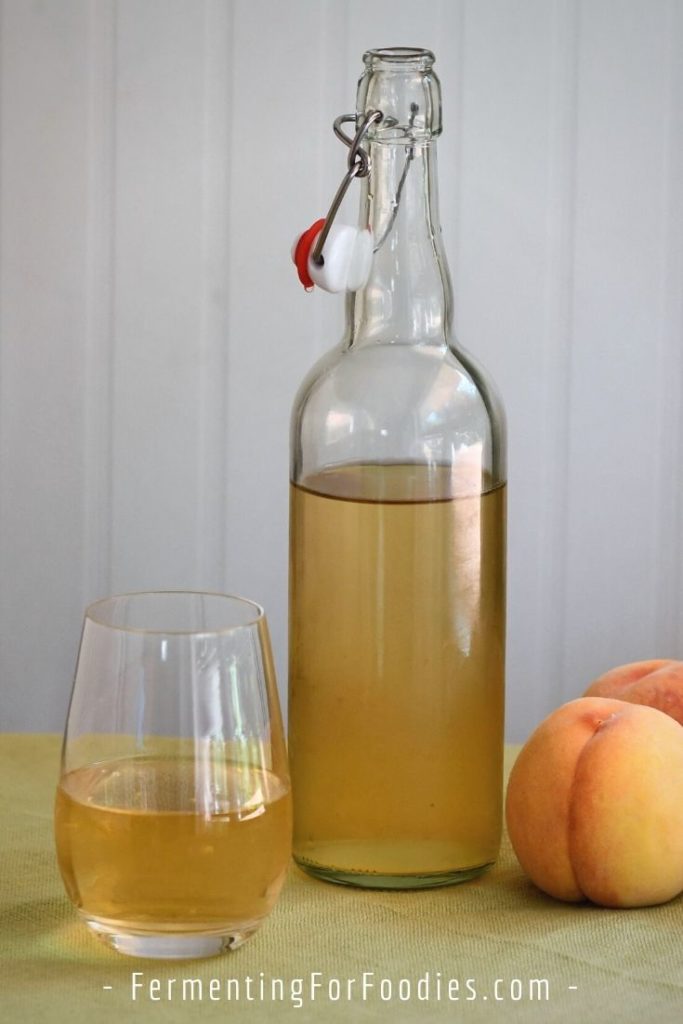
Homemade Peach Wine
Peach wine is sweet and refreshing. Serve chilled for a delicious burst of summer flavor. See the section above for instructions on creating your own balanced peach and fruit wine by substituting a portion of the peaches with rhubarb, berries, plums or pears.
- Prep Time: 30 minutes
- Total Time: 30 minutes
- Yield: 3 litres 1x
- Category: Alcohol
- Method: Fermentation
- Cuisine: Traditional
- Diet: Vegetarian
Ingredients
- 2.5 lbs of ripe peaches
- 14 cups of filtered water (chlorine-free)
- 2 lbs of sugar
- 1 1/2 tsp acid blend
- 1 tsp fresh lemon juice (not bottled)
- 1 tsp yeast energizer
- 1 tsp pectic enzyme powder (optional)
- 1/4 tsp tannin (optional)
- 1 packet white wine yeast (LALVIN 71B-1122)
Instructions
- Follow the basic winemaking steps, including sanitation of ANYTHING that is going to touch the fruit. See the section above if you need more detailed instructions on the steps involved in making wine.
- Wash the peaches. Quarter them and remove the stones and any bad spots. However, you can leave the skins on.
- Put the peaches in a large pot and use a potato masher to coarsely mash the fruit.
- Bring all 14 cups of water to a boil, then pour the boiling water over the peaches. I often do this in batches, because pouring that much boiling water is difficult.
- Put a lid on the pot and stash it in a quiet corner of your house.
- After 24 hours, add the sugar, acid blend, lemon juice, yeast energizer, pectin enzyme powder, and tannin. Fully stir to mix in the ingredients.
- Follow the instructions on your yeast package (mine involves re-hydrating before use) and stir it in as well.
- Give everything another good stir one hour after adding the yeast to make sure it is well mixed. If you want to calculate the alcohol levels, remove some of the liquid at this point to measure the specific gravity.
- Put the lid back on the pot, and leave it somewhere warm to ferment for 4 days. Give the mixture a good stir once or twice a day.
- After the first 4 days of ferment, filter out the solids and move the liquid to your carboys. In general, it’s better to leave some of the liquid behind in the solids than to have solids in your carboys (see notes).
- Top the carboys with an airlock and leave them somewhere dark to ferment for 3 weeks.
- After 3 weeks, rack the wine into a clean jug for another round of fermentation.
- After 3 months the wine is ready for bottling. The bottled wine needs to age for at least 10 months to develop a nice mellow flavor. I’m often tempted to sample early, but it’s always a disappointment.
Notes
- If this is your first time making wine, see the section above for more information on each of the steps involved. Alternatively, try a simple recipe for fruit juice cider.
- I enjoy adding a second fruit to peach wine to round out the flavor. It will help to add depth to this mild fruit. See the section above for more information and suggested fruit combinations.
- I use an autosiphon to move the wine to my carboys. Then when there’s mostly just pulp in the bottom of the pot, I pour the liquid through a strainer to get out the rest of the liquid. This remaining liquid isn’t ideal for wine. Instead, I bottle it up for a quick cider-like beverage.
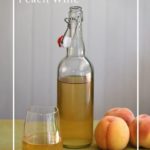
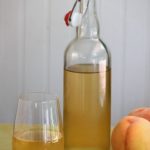
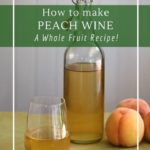
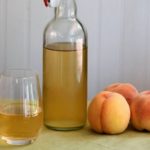
Hi Wanting to try this wine, is the 14 cups aprrox 1 gallon of water? Thanks
Almost… it’s just two cups short of a gallon. However, if you’re wondering what size container to use, you’ll need at least 1.5 gallons. (I always make a larger batch, so I don’t know exactly.) Enjoy!
I did a batch of this last summer and just tried a bottle. I really like it.
If I wanted to do a double batch, would I double everything?
Yes, exactly. We always scale our batches depending on how much fruit we have. 🙂 Glad you’re enjoying it!
I was wondering what other fruits or berries would combine well with peaches in this peach wine?
Whoooops, just saw the section on peach blends. I will definitely try the rhubarb peach combo, as I will have a ton of rhubarb in the garden, once the snow goes away here in Vermont.
Will rate this recipe when I try it – soon. I have frozen peaches and blueberries in the freezer right now.
Thanks!
Great! Blueberry peach sounds delicious.